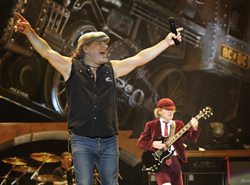
As time and space would allow, we walked through some of the highlights of outboard in deployment in Pab’s trick bag. “Radial sent me a JDX Phaser, a tube leveler for Brian’s vocals, GML-8200 with four bands of parametric. Because the console is of an older design, the EQs are very basic.”
He also employs DMX 160X and Drawmer DS201 gates. “They’re simple, functional, and that’s it. It’s a very simple setup – even with mic’ing seven cymbals, I’m still only pushing 30 inputs. You could probably do this whole show with about 18 inputs. It’s not input heavy. It’s very straight forward, kick, snare and hat. It’s very loud, two guitars, slam a vocal in there, a bass as well – you have AC/DC.”
Monitors Loud And Proud
AC/DC’s Monitor Engineer Mike Adams started off his career in Denver, CO, and still lives in the area. I asked him how he got into this business he pondered for a moment smiled and answered with a genuine excitement in his mild demeanor.
“I started when I was a young teenager and was always fascinated as to what the guys were doing behind the consoles so I started sneaking into night clubs in the Denver Metro area when I was about 16 years of age. I traded my labor out to the guys that were doing shows in the clubs that I thought made it sound really good. So I just offered to hump their PA out the door if they would sort of tutor me. I had a couple of really good mentors at an early age. The year I started actually making a steady paycheck at it would be approximately 1981. I was paid before that but it was only spotty.”
He’s worked with such notables as the Stones and John Mayer. “I did the first spring with John Mayer and then I got the Stones. I did Motley Crew, Pantera, Kiss for years, Third Eye Blind, Luther Vandross, it’s been pretty much everything,” he says.
For the current tour, he’s mixing on a Midas Heritage 4000, about which he states, “Because of the way that I feel about it, even though there are a couple of really solid digital surfaces now, especially with a band that I think that is used to hearing things with a little bit of harmonic distortion and a little bit ultra sagging, it adds a certain depth. It’s not that you can’t get it with a digital surface.
“At this point in time I prefer an analog console. I have used digitals before and you can get great results with them. I will say if there were ever an issue, I would rather be sitting with an analog desk than a digital desk. Plus output wise, I’ve got 40 outputs and I need someone to show me a digital desk that will do that – other than a couple of them. Getting strapped with 16 plus 8 is not really how I want to roll.”
“All the mics on stage are definitely picked by Pab – even though Pab welcomed any input, but all the ones he selected I’d used before and they’re working just fine. We have Shure products in our vocal line all the way across, Brian’s hand-held, 58A, and all the background vocals – everything goes on Shure. We have some Audix products onstage. Everything is sitting real well right now.”
The first rack in Adams’ arsenal is a PSU rack. He has a dbx IEM processor. “We put a little tweeze on the Brian’s ear mix with that,” Adam’s said. Above that is some Meyer EQ to do a little notching in the drummer’s ears as well as in Brian Johnson’s. “That’s just to relieve a little bit of the pressure,” he went on.
The next rack over was a TC 1128’s used across all his loudspeaker outputs, it has a single brain control but it is an analog EQ. The next rack is dynamics. Avalon 737s take care of Brian’s ear vocal mic, and there’s also one on high-hat.
“I’m using a couple of H3000s, one main, one spare, just for a little enhancement in the wedges.” Then he has the usual compliment of Apex Gates. “I do have some tc and Lexicon processing but it hasn’t been implemented yet because we need to set them in a super dry environment. It’s coming,”
For more images, be sure to check out the photo gallery that accompanies this article.
